Picea sitchensis 'Bentham's Sunlight'
Most folks around here know the intriguing story of the golden sitka spruce that once lived on Queen Charlotte Island in Canada. Gordon Bentham was a friend of Jean Iseli's and gave him scion off of the mother tree back in 1981, (at that time we simply named the tree, 'Aurea'). The specimen pictured here was planted from a container grown graft a couple years ago. Up until a few months ago it was growing in the shadow of a much taller golden Cedrus. The Cedrus was removed and within the past several weeks I have enjoyed watching this beautiful specimen begin to color up to its reputation.
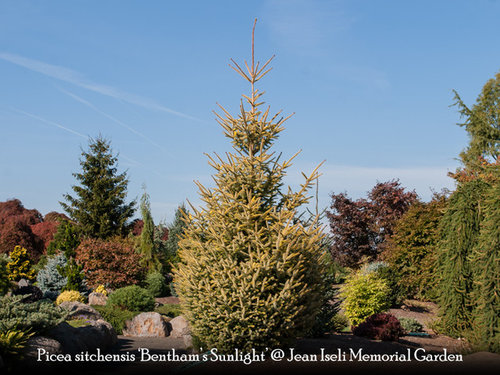
Comments (93)
arceesmith
Original Author11 years agolast modified: 9 years agoNow that the bizarre and twisted narrative, which includes accusations of ignorance, greed and deception, has come to completion by one member of this forum, I believe it is time to return to the true facts.
I began this thread, not as an official representative of Iseli Nursery in some marketing scheme, but as a fellow lover of all conifers, excited about a new development in our fascinating realm of horticultural science. Now that my integrity, that of my associate Paul Halladin, and the hardworking staff of Iseli Nursery has been thrust into question, I find that I must take a different role.
This is a public forum which should be professional and civil - where the sharing of knowledge and experience is what makes it a great resource for anyone interested in conifers. I am truly surprised with the stance taken by Edwin, that we at Iseli Nursery are both deceptive and ignorant. His record keeping and nomenclature passion and skills are admirable, but to suggest that the Queen Charlotte Island golden clone of Sitka spruce can never be propagated to develop a strong leader and begin to grow with the characteristics of its mother plant is erroneous. To then fabricate a slanderous story of complete fantasy based on narrow-minded disbelief is, frankly, embarrassing.
Following are the FACTS as presented by Paul Halladin, head propagator at Iseli Nursery for the past 32 years. Any other narration regarding the Iseli Nursery clone of the Queen Charlotte Island Golden Sitka Spruce (as pictured in the opening post of this thread) should henceforth be recognized as pure fantasy.
* Iseli Nursery acquired the cultivar named Picea sitchensis 'Aurea' in 1981 from Gordon Bentham. The origin for these plants was the legendary Golden Spruce from The Queen Charlotte Islands. The only yellow Picea sitchensis cultivar received and subsequently multiplied at Iseli Nursery is the one from Gordon Bentham.
* This tree has been propagated and distributed to others including the UBC Botanic Garden. The UBC accession year was 1978 with the name Picea sitchensis 'Aurea'.
* Bob Fincham also received plants labeled Picea sitchensis 'Aurea' in the 1980s from Mr. Bentham, but subsequently changed the name to 'Bentham's Sunlight'. Bob has written that the reasoning behind his proposed name change was that he personally saw full sized trees labeled 'Aurea' in Australia in 1993. He concluded the trees growing in Australia were different than the QCI Golden and a new name was needed. I trust the intent from Fincham was for clarity but it has inadvertently caused some confusion; one cultivar distributed with two different names.
* The parent QCI Golden Sitka spruce has been documented since 1924. Before its demise in 1997 it was reported to be 300 years old and 165' tall (the link provided by, jth97381, in post #29 of this thread shows a tall yellow forest tree).
* When a plant is propagated and given a cultivar name the goal and responsibility is to reproduce and maintain the desirable attributes, including form and habit of the parent.
* The goal at Iseli Nursery for this selection was to reproduce a tree. To reproduce a tree form, the scion wood needs to be vertically oriented. Lateral Sitka spruce shoots produce dwarf branchlike plants.
* The first step is to rejuvenate stock with the correctly oriented shoots for grafting. The distorted plagiotropic original stock (photos in post #6) took many years to develop strength. We picked and grafted the best upright tending shoots and with appropriate cultural care grew these propagations for a number of years and repeated the process of selecting the best vertically oriented shoots. With this bright yellow cultivar, it took a few propagation cycles, or approximately 15 years, to change the grafted offspring from weak spreading dwarf plants to sapling straight rejuvenated trees. The lesson from this tree is the importance of patience and attention to the details of basic propagation principles, and cultural care, to achieve the desired end result (photos in the original post and in post #6 of this thread).
* Genetics and horticultural skill don't guarantee all will be exact copies. Trees respond to the environment and follow patterns of development depending on external factors. Light, water, soil, weather including wind and temperature, and physical space are important in determining tree development. Also included is the variable of time.* A weak spreading branchlike habit is created from selecting and grafting lateral branches and can be maintained for decades, or can also be perpetuated in future reproductions if lateral shoots, instead of vertically oriented shoots are used. Light-starving compounds the weak branchlike shape, essentially mimicking the development of a shaded lower branch of a forest tree with the corresponding short growth, small bud development, horizontal branching and sparse flat needle arrangement (photos in post #21 and 23 are perfect examples). Contrasting the appearance of lower shoots, the vertically oriented shoots such as found in the crown of a tree or seedling, have needles arranged in a radial pattern. The buds located on vertical shoots at the apex of a tree, that have sufficient light, develop larger and produce a long shoot, which becomes the pole or trunk of the tree. For collectors with limited space, a struggling distorted cultivarient - a dwarf plagiotropic oddity - may have interest, but it seems disrespectful to purposely grow this grand old tree as a weakling, considering its pedigree.
* The QCI Golden has not been, and was never expected to be, a commercial money-generating product for Iseli Nursery. It took 19 years before we had grown trees that were considered of saleable standards. The first trees were sold in 2000. We sold a total of only 211 trees labeled as Picea sitchensis 'Aurea'. We stopped propagation a number of years ago with the last remaining trees sold in 2010. Our hope is that some of the trees have been planted with permanence in mind not ephemeral gratification.* Although it never was a tree planned or expected to be produced in commercial levels, it has remained a very special tree for us at Iseli Nursery. I have very fond memories of the day Gordon Bentham brought a load of treasures, including the QCI Golden, to share with Jean Iseli, and the enthusiastic banter between the two of them as we unloaded the plants. Both of these men were important mentors at the start of my career at Iseli Nursery, and this tree is a link that reminds and holds their memory - I will not forget them.
* We planted a clone of the QCI Golden in the Jean Iseli Memorial Garden a few years ago in a prime spot and it is settling in nicely, as seen in Randy's photo at the beginning of this thread. We look forward to watching it grow and develop, expecting it to thrive for others to appreciate long into the future.
* The story of this tree has been creatively documented in the book, The Golden Spruce: A True Story of Myth, Madness and Greed, by John Vaillant. Its story continues to be revealed. The undying magical strength of a single tree persists, long live the Golden Spruce from the Queen Charlotte Islands, a remarkable tree.
We share this information in the hope that others will invest the time and diligence required to propagate and grow this magnificent tree so it reaches its full potential.
My best to you all,
Randall C. Smithmonkeytreeboy15
11 years agolast modified: 9 years agoWhat a comprehensive and authoritative post, Randall.
I appreciate your thoroughness in straightening out this mess. I will remember the true history of this tree now, and will hope your beautiful specimen at Iseli will not burn!
-Sam
Related Professionals
Beachwood Landscape Architects & Landscape Designers · Harvey Landscape Architects & Landscape Designers · Maple Valley Landscape Contractors · Biloxi Landscape Contractors · Englewood Landscape Contractors · Inglewood Landscape Contractors · Mashpee Landscape Contractors · New Baltimore Landscape Contractors · Porterville Landscape Contractors · Red Oak Landscape Contractors · Tavares Landscape Contractors · Waterford Landscape Contractors · Wayland Landscape Contractors · Welby Landscape Contractors · Maplewood Landscape Contractorsconiferjoy
11 years agolast modified: 9 years agoRandall, thanks for your wonderful story, but still you don't show us some evidence that you're right about the "true" 'Bentham's Sunlight'.
It's seems here that everyone, except for you, sees that the Iseli one is not the right 'Bentham's Sunlight'.
The only one in the U.S. in who I trust in having the true 'Bentham's Sunlight' is Bob Fincham of Coenosium Gardens.
Last winter I saw a specimen in his garden which was way differend then the "Iseli one".
I also saw the one's at Will's, our "firefighter" garden.
As I do have a perfect photographic memory, I kept these all in my mind for ever.
For this reason I know what I'm talking about, if I had my doubs for halve a second, I wouldn't go this far in this topic, but I do know that I'm right.Also in Europe we have the Iseli form, Henk's and Clement's plants derived in some way as scions from the Iseli Nursery.
How much more proof do I need to show that you're wrong?Both persons also have the true 'Bentham's Sunlight' in their collections, so comparisons can be made and were shown here.
The most beautiful thing here in The Netherlands and Belgium is that we have our world wide famous conifer collections, with over more then one thousand conifers in each collection.
We do have a very good contact with eachother and we're sharing information regulary, also in this case and we all came to the same conclusion which I'm telling here all the time.Without comparison and sharing information you will get "blind" for certain conifers which is happening in this case...
Randall, I know that I'm right for a 100%.
Again, my intention is to help the Iseli Nursery in using the right names, just like I recently did with the Picea omorika 'Gotelli Weeping' which they were selling as 'Pendula'.
Please consider this and show Paul this topic, may be you did allready.
I hope that the both of you will change your minds now...arceesmith
Original Author11 years agolast modified: 9 years agoEdwin, I can only guess that we suffer from the differences in our native languages. I cannot make the facts any more clear than they have been presented here.
It is true, we appreciate that you made us aware of the name change regarding the Picea omorika 'Gotelli's Weeping' (Which is an entirely different situation than what we have in this case.) We were happy to bring the name up-to-date as soon as we were made aware and verified that the cultivar we had received in the 1970s as 'Pendula' had its accepted name changed to 'Gotelli's Weeping'. I thanked you for that information and Iseli Nursery changed the name in our records.
The facts regarding our clone of the QCI Golden Sitka spruce stand on their own. We do not need to change our minds about anything regarding the source of our clone, nor about our experience in its rejuvenation to the growth habit and form of the mother tree, as described above by Paul.
You are free to believe that you are 100% correct. That is unfortunate in this case, and will not change the truth. I do hope that you will take the facts, as presented here, as an opportunity to learn something that you have not yet encountered in our field of horticultural science.
Embothrium
11 years agolast modified: 9 years agoIf it doesn't burn in patches then it is not matching the Haida tree. If it does not remain yellow in shade then it is not matching what others believe to be propagations of the Haida tree. As I have related an example of your stock that I bought from one of your customers immediately turned effectively completely non-yellow when planted in a woodland glade, with intermittent sun exposure.
Differences in habit could be accounted for by cultivariance and influence of rootstocks, as is often seen in other grafted conifer cultivars. But what about the three different foliages and behaviors shown and described here, with more than one specimen of each type (except for the one version of 'Aurea') that aligns with others being grown under the same names?
Embothrium
11 years agolast modified: 9 years agoOkay, I see now you are saying you developed the "Iseli Gelb" from the weaker version of 'Bentham's Sunlight' - that the starting material for the development of the one definitely came from the other, on the same site. The "improved" stock being less sun-sensitive could certainly be related to it being less inclined to retain the yellow.
I planted the one I bought in a semi-wild setting with exactly the intention you say here you hoped someone would have, that of establishing a new example of the Haida spruce that would be able to live on for years and develop some size. The owner of the property intends to leave it to the community somehow, maybe as a gift to the county. However, as I mentioned the terrible corkscrew rootstock I discovered at planting casts serious doubt on the specimen being able to last.
Unless it roots out on its own at some point, and this is enough to keep it upright and long-lived.
arceesmith
Original Author11 years agolast modified: 9 years agobboy - Yes! Thank you for looking things over again.
I believe that we have a lot to learn through further observation. I do have some specific theories about what has happened/is happening that I look forward to discussing with the group (which was the intention of my post in the beginning). This is a fascinating subject that I honestly do believe we may all learn from if we approach the subject with fairness and open minds.
It is late now, but I will be delighted to return and share my thoughts on this subject within the next day or two.
coniferjoy
11 years agolast modified: 9 years ago"Okay, I see now you are saying you developed the "Iseli Gelb" from the weaker version of 'Bentham's Sunlight' - that the starting material for the development of the one definitely came from the other, on the same site. The "improved" stock being less sun-sensitive could certainly be related to it being less inclined to retain the yellow."
What a nonsense!!!
A plant has the same DNA from bottom till the top, and for sure it's colour will remain the same when planted in the same situation!I waited with this answer because yesterday I had two U.S. conifer nurseriemen here visting my nursery.
These men were Eric Bizon (formerly employee at the Buchholz Nursery) and Brent Markus of the Rare Tree Nursery.
Both are pretty familiar what is going on with this conifer and Brent claimed that he's having the oldest 'Bentham''s Sunlight' in the U.S.
This specimen has a semi flattened growing habit, just like two at Randall's photos.
Both admit that the true propagated 'Bentham's Sunlight' never will make a leader of their own, they allways have to been staked for a while.We also discussed IF there's was a branch on one of the stockplants which had less intensive yellow, then we're dealing with a mutation which is differend from the original one.
In this case you can never sell it under 'Bentham's Sunlight', but you've the give it a new proper cultivar name...ishcountrygal
11 years agolast modified: 9 years agoThank you jth97381 for the link to the photo of the Haida Golden Spruce! And thank you RC Smith and Paul Halladin for the careful explanation of the steps in developing your golden spruce.
I have been trying to work out the biology of this in my head. Please, anyone who has a better understanding of this help me out.
jth's link shows that the Haida spruce was a tall (50 m) and strong-growing tree. Sorry about the caps, but:
... THE DNA IN CUTTINGS OF THIS SPRUCE HAS THE POTENTIAL OF PRODUCING A MAJESTIC 300 YEAR-OLD TREE.But the factors influencing an organism's growth are lumped into GENETIC (simply the DNA sequence) and ENVIRONMENTAL. The environmental component would include everything else. For example, the other molecules and the kinds of cells within the tissue, the rootstock, soil, air, sun, wind, insects, pathogens and so on. So there's a lot of wiggle room for a plant's character.
Using the mighty google, I see references to genetic hardwiring vs. phenotypic plasticity.
A search on "phenotypic plasticity of conifers" brings up several hits. It seems that this is a strategy for long-lived conifers to deal with a more rapidly changing environment. This is of interest to scientists because of concern about the effects of climate change on conifer populations. If a 300 yr-old conifer produces a seedling, that seedling may start out in an environment that's measurably different from that of its parents. As another example, a conifer may need to deal during its lifetime with much faster reproducing and thus evolving insects and microorganisms.
Although the studies of phenotypic plasticity look at how trees respond during their lifetimes to changes in their environment, it seems that this also would apply to successive propagation with grafted cuttings.
So, during the lifetime of an individual (or clone), genes do not change, except for mutations, most of which have no apparent effect. However:
... DURING THE LIFETIME OF AN INDIVIDUAL, GENES MAY BE DIFFERENTIALLY EXPRESSED.
So, it might be possible, starting with a majestic Haida spruce, to produce scraggly trees grafted from cuttings, and then with repeated and careful selection of cutting material and environment, to eventually come up with trees with a character more like the original, including perhaps the vigor, shape, and needle color, length and thickness.
I will listen respectfully to any further discussion of this topic on this public forum.
-m
Embothrium
11 years agolast modified: 9 years agoFrom photos of it, admittedly taken from some distance it appears the original has the lighter yellow, sunburning foliage of the shrubby propagations with the tree habit of the Iseli stock. With other conifer cultivars you can get more robust plants merely by grafting onto non-dwarf seedling rootstocks, resulting in stock that does not provide the dwarfness of the original seedling or branch mutation - foliage characters can also differ, as a part of the total overall plant habit being different. That is what I was talking about when I mentioned a different type of yellow coloring could be associated with greater sun resistance when I posted the above "nonsense". This is seen in other yellow cultivars, for instance the 'Golden Mop' threadbranch cypress being more sun resistant than other, otherwise similar yellow forms. Somewhat different foliage appearance and behavior occurring in conjuction with the production of consistent apical dominance of the spruce does not seem impossible to me at all. Lawson cypress cultivars do this on their own, as a normal course of development, the fertile, cone-bearing foliage having a different structure - and often, different level or dispersal of yellow or white coloring, in the case of such forms - than the sterile foliage the plant was producing when planted. Sawara cypress cultivars are very plastic, with some forms generating more than one type of growth from the same specimen.
coniferjoy
11 years agolast modified: 9 years agoRon, you proved me right with your Chamaecyparis pisifera 'Golden Mop' story.
The 'Golden Mop' was found as a compacter and less yellow branchmutation on a 'Filifera Aurea'.
Because of this difference in shape and colour it was given another cultivar name.If Randall's story is right, the Iseli Nursery must do the same thing with their branchmutation.
They still name it 'Bentham's Sunlight' which is a complete differend one, as we can see at several pics here.Thanks Ron, you're a great guy :0)
coniferjoy
11 years agolast modified: 9 years agoYup, but only to set things straight, nothing personal :0)
bluespruce53
11 years agolast modified: 9 years agoEdwin, as we know many cultivated spruces, especially dwarfer kinds and those possibly originally propagated from weaker side growths can and do put up much stronger branches sooner or later. These are not mutations in any way in my opinion. We know some are reversions etc, but in this case any stronger growth from the otherwise weaker original propagations are more likely to be in keeping with the original tree. So you could possibly say that all the original weaker plants should be discarded in favour of the more vigorous propagations now being released by Iseli ? ... just a thought! :o)
coniferjoy
11 years agolast modified: 9 years agoStephen, you're right but in this case the "Iseli form" is very differend from the true 'Bentham's Sunlight' and because of that it needs another cultivar name.
If people want to buy a 'Bentham's Sunlight', they will only go for the true one, and not a fake spruce with the same name...It would be much more interesting for the "Iseli Form" to tell their customers and us forum members via Randall that they found a much more better selection out of the 'Bentham's Sunlight' which can stand the sun much better without any problems.
To make clear that their form is better for all light circumstances, it would be very smart to name it differend like 'Iseli Sun Catcher', because this one likes the sun instead of hate it...severnside
11 years agolast modified: 9 years agoSo Edwin, you are saying that if a side branch propogation produces a set of characteristics and is named then only those exact characteristics can be the named cultivar from then on? To produce different characteristics from the same parent stock, even if they are more like the parent must have a different name? The name is for the characteristics captured that one time and must be replicated to be that cultivar. A bit like producing an upward growing Abies procera 'Glauca Prostrata' and still calling it a 'Glauca Prostrata' though it may be more like the original 'Glauca'. The confusion may arise here if the new propogation is considered superior and that 'Bentham's Sunlight' makes no reference to form etc. in the name.
coniferjoy
11 years agolast modified: 9 years agoSevern, the Abies procera 'Glauca Prostrata' is nothing else then a side branch taken of an Abies procera 'Glauca', but because it's habit is differend it was given another cultivar name.
As soon as a 'Glauca Prostrata' will develop a leader and will grow into a tree, it's name will go back to just 'Glauca' which is strange, but true...The "Iseli Form" is way differend from the 'Bentham's Sunlight', in it's growing habit and agreement in sun.
For these reasons it needs another cultivar name which will avoid furthur confusions in both plants.
Now I hope this is clear for you as well :0)maple_grove_gw
11 years agolast modified: 9 years agoSo, is a genetic mutation required for a new cultivar, or could a cultivariance alone (and the resulting phenotypic variation as described by ICG above) be sufficient? I understand of course that normally nursery stock does not undergo genomic sequencing and so there is a large dose of geusswork here, but how is it supposed to work?
arceesmith
Original Author11 years agolast modified: 9 years agoJust a quick note - I have little time - I do not know where the misunderstanding has arisen that our rejuvenated QCI Golden clone has full sun tolerance. I did state above that in the past, ours have experienced sunburn when grown in full sun. The one pictured has only been in full sun for a couple months.
Sorry - all I have time for - life is busy. Please continue the discussion...
Embothrium
11 years agolast modified: 9 years agoI observed that the Iseli version was not burning up in the open in a retail nursery yard here, there was only a little damage versus the complete inability of the "true" stock to take sun - Bob Fincham had said in the previous thread the earlier type would burn up and die in the open in Oregon, the stock now at Iseli would appear to be something different if it could grow away from sun protection. The photo on this thread of the unshaded potted stock at Iseli would also tend to indicate it was more sun-resistant, the traditional version would also seem to be so prone to damage that if the recently uncovered "Gelb" shown at the beginning of this thread behaved in the same way it would have burned up soon after being newly released from shading. The pictures of the shrubby, shaded stock at Iseli show them with damage even in their shaded positions.
Since I have seen at least one photo of the original wild tree with patches of brown of some size, I would say the Iseli stock is not, in fact an exact duplication of the wild tree. The sections of deep yellow bordering on orange it can show would also seem to be different. At this point the discussion pivots on whether or not the differentness of the Iseli stock is enough for it not to belong to the same clone as was received from Bentham. Since the managers of the Iseli stock are certain it is derived from the Bentham scions, the only way left to establish a different clone has been produced instead is genetic testing.
All propagations of a clone should receive the same cultivar name, regardless of how they grow and behave, unless a different-growing version is known or fairly certain to be from a genetic mutation that makes it genetically different and therefore not the same plant in its entirety - the genes are where it is at, not the plant body.
Switching names back and forth with changes in the growth behavior of cultivariants is not what those who are trying to be accurate or reduce confusion promote. A 'Prostrata' redwood is really a 'Cantab' and should be called such, and so on. If a variation pops out of a plant and remains constant through repeated propagations, there is an implication of a genetic change having made it an actual different plant warranting a cultivar name of its own. If instead it produces multiple episodes of a return to the habit of the parent plant it is assumed to be a cultivariant, and not really different.
coniferjoy
11 years agolast modified: 9 years agoThe reason that we're thinking differend here is because I'm a nurseryman who's also selecting conifers, just like the Iseli Nursery is doing.
I'm naming my selections with "Filip", they're doing it with "Iseli".
These "trading marks" are standing for a good quality and differend plant, which were selected for good reasons.The Iseli Nursery should be very proud of their "better" 'Bentham's Sunlight' selection too, but no, they want to mix it up with the one which is very difficult to grow and will burn all the time.
This is not smart thinking and it will be only a matter of time for another topic here:
"I just bought a 'Bentham's Sunlight', is this the right one"?Well, I spend enough time here to make myself clear in the way I think how the situation is.
Now it's up to you folks what to do with it...bluespruce53
11 years agolast modified: 9 years agoThat's a valid point Edwin, certainly not desirable to have two entirely different plants in habit bearing the same name in circulation, even if they do originate from the same source.
arceesmith
Original Author11 years agolast modified: 9 years agoNow that the discussion has come to simply a matter of nomenclature, we may have found a place of agreement. When I originally made the opening post of this thread, I used the name, 'Bentham's Sunlight', that had been attributed to the cultivarient of the QCI Golden Sitka spruce; they are, after all, propagations from the same mother plant. It had seemed unethical to name our rejuvenated clone something different than what has become the recognized and accepted name of offspring created from the same mother plant.
We referenced what a late colleague, the highly respected conifer enthusiast, Humphery Welch, said in his World Checklist of Conifers, regarding the specific question of nomenclature and its relation to cultivarients, (and was briefly mentioned above, regarding Abies procera 'Glauca Prostrata').
"This name is now widely used for cultivarients (ie. Plants with a low, spreading habit and no leader), individually produced by use of side shoots for propagation. Note: Such are not a clone in a biological sense and are apt to develop a leader and become arboreal, making nonsense of the word "Prostrate" and to save disappointment it is safer to offer such plants as 'Glauca' adding the words Prostrate form not part of the name but as a 'trade description' of each actual plant."
All of that being said, it does seem that a logical and wise solution to prevent further confusion would be to give the rejuvenated form a different name. I have been referencing the plant pictured above as the QCI Golden Sitka spruce. We believe this may be a good name for this form, 'QCI Golden'. This would allow the cultivarient, 'Bentham's Sunlight', to remain a distinctive product for conifer collectors and enthusiasts and would distinguish the rejuvinated tree form for further observation.
Let me emphasize one more time, Iseli Nursery is not actively marketing or distributing either form of the Queen Charlotte Island Golden Sitka Spruce. This thread was originated to share an exciting development in the fascinating history of this grand tree.
I trust that the slanderous accusations have come to an end and that we may all enjoy learning more about our beloved world of conifers.
My best to you all,
Randall C. Smithishcountrygal
11 years agolast modified: 9 years agoNaming is complicated!
The Queen Charlotte Islands no longer exist.
In 2009, the Haida Nation and the B.C. government negotiated a name change to Haida Gwaii, which became offical in June 2010.
Perhaps the Iseli spruce could be named 'Haida Gwaii Golden' or 'HG Golden'. Then both the form and the name would pay homage to the source of this cultivar.
Here's a video from the council of the Haida Nation with puppets presenting the legend of the Golden Spruce: http://www.haidanation.ca/Pages/Haida_Legends/Golden_Spruce.html.
-m
Here is a link that might be useful: CBC: Queen Charlotte Islands renamed Haida Gwaii in historic deal
arceesmith
Original Author11 years agolast modified: 9 years agoIshCountyGal - A wonderful contribution - thank you! We will have a look at your link and give worthy consideration to your name suggestion.
clement_2006
11 years agolast modified: 9 years agoWhy not just 'Haida Golden' or 'Haida Gold' ??
Clementbobfincham
11 years agolast modified: 9 years agoAny name referencing Haida is referring to the true 'Bentham's Sunlight' and would continue the confusion. The name needs to disassociate it from the original form especially since it does not appear to have anything in common with that plant's characteristics.
Bob
Embothrium
11 years agolast modified: 9 years agoI agree, except if the Bentham plant and the Iseli 15 year selection process version is the same genetic material it is the same cultivar, and should not have two completely different cultivar names. Other cultivars vary with propagation method yet are still one cultivar. Suppose the original tree was still standing and I went and climbed it, grew grafts from different parts of the canopy, and these happened to also persistently grow in different ways based on where on the parent tree they came from (this is a common basis for cultivariance). Should I give a different cultivar name to each one of these types?
No.
bluespruce53
11 years agolast modified: 9 years agoNot strictly true bboy, the improved 'Bentham's Sunlight' has been produced over a period of time selecting stronger growing shoots from the original propagations. These new plants now bear no resemblance to the originals, It's not just a matter of varying climatic or growing conditions they are completely different from the word go.So to stop any confusion I agree a new cultivar name is justified, even if it is something like 'Bentham's Sunlight Improved' just to maintain the conection between the two forms.
bobfincham
11 years agolast modified: 9 years agoI waited to comment on this thread until I was able to visit Iseli Nursery to see the actual tree in question. I spent time there yesterday with Paul and this tree is definitely the one I named 'Bentham's Sunlight'. It is an excellent specimen. The removal of the tree that was shading it has caused some slight defoliation at the branch tips. In the direct sun the yellow is not as bright as it could be but moving to the shaded part away from direct sunlight the color intensifies nicely. Here are a couple of pictures from yesterday.
http://i624.photobucket.com/albums/tt321/bobfincham/BenthamsSunlightIsSm_zps814b4297.jpg
http://i624.photobucket.com/albums/tt321/bobfincham/BenthamsSunlightFoliageIsSm_zps4a551520.jpg
bluespruce53
11 years agolast modified: 9 years agoI'm confused ... I don't now doubt this is the true form if you now say so Bob, but what is the other weaker form that has been distributed under the name 'Bentham's Sunlight' ?
ishcountrygal
11 years agolast modified: 9 years agoBob, thanks for the update and photos.
I like the winter color - an icy gold? Are the very dense branches the result of pruning or ??
-m
bobfincham
11 years agolast modified: 9 years agoOnce a specimen "takes off" it produces lateral terminals over 6" (15 cm) long that should produce young plants capable of developing some apical dominance at a young age. Until this happens, propagations from smaller terminals will grow at a slower rate and will tend to "meander" until eventually developing into a tree.
The weaker form should develop into a tree, it will just take longer to do so. Limited sunlight when younger plays an important role since even the Iseli tree has sun scald at the ends of the terminals where the sunlight is more present.
This tree has not been cut for years and its density is natural growth. When it is growing, it does produce many lateral buds leading to extensive lateral branching.
ken_adrian Adrian MI cold Z5
11 years agolast modified: 9 years agothe coffee is kicking in..
i havent put all the above to memory..
but what about a pun name.. like
'Bentham Sunlight's Son'
or
Sun of BS' .. lol ... i meant that ... oh you know what i mean ...
'Son of Bentham Sunlight' ...
aw heck.. lets just call it 'And Bob's Your Uncle' and be done with it ... lol ... or!!! ... 'And Bentham's Your Uncle' ....
regardless.. i want one.. and i wonder if it will survive in z5 MI????? .. you all claimed my 'papoose' would never survive .. and it has ... [though it was snow covered for its first 5 years] ... but i dont have any other sitchensis' .... opinions regarding such???..
[or in the alternative.. anyone care to send a trial plant.. lol .. ah the Christmas season.. gratuitous begging.. lol ... speaking of which.. where are the kids ....]..
Merry Christmas and Happy new Year to RC and bboy and bob .. since i dont see them lurking everywhere else ... [and of course.. the rest of you]
ken
arceesmith
Original Author11 years agolast modified: 9 years agoI knew Bob was going to visit the garden, but unfortunately I was out of town at the time. Even though I have popped into the forum a time or two, I had totally missed the recent updates to this thread. I am pleased to see that Bob has reported about his visit here.
Let's all make 2013 a great year for Cone Heads!
ken_adrian Adrian MI cold Z5
11 years agolast modified: 9 years agoi was told.. in no uncertain terms .. that this will DIE!!!! in z5 ...
it is officially a piece of carp.. and i hate it .. lol ...
ken
tsugajunkie z5 SE WI ♱
11 years agolast modified: 9 years agoNo, not fish. Carp as in carpus delicti. You know, evidence it will die in zone 5. lol
tj
tunilla
11 years agolast modified: 9 years agoWell,I can see a herringbone pattern as well!!! Happy New Year! T.
clement_2006
10 years agolast modified: 9 years agoconiferjoy
10 years agolast modified: 9 years agoClément, they look differend, don't you think?
The 'Aurea' is a light green, while the 'Bentham's Sunlight' is a bright lemon yellow. Please, can you also show us a new picture from the 'Aurea' without the sun exposure?
Then you realy can see how green it is.
Thanks!I also was wondering if we can see a close up pic now of the one at the Iseli Nursery with the new growth on it.
I'm very interested to see what that colour is...clement_2006
10 years agolast modified: 9 years agoOK, no sun today, possible rain.
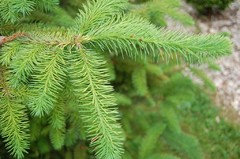
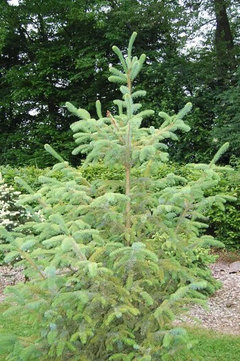
Picea sitchensis "aurea" push green (light green), stronger.He make a leader easily. like show all the photos posted before ,by this way all the plants are conical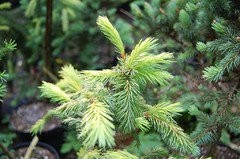
Picea sitchensis "Bentham's Sunlight" push yellow, like show all the photos posted before, all the plants start bushy, making a poor leader often after many years.
Definitivly 2 differents cultivars.
Clementconiferjoy
10 years agolast modified: 9 years agoThanks Clément for your other pics taken without the sun exposure.
Now we can realy see how differend they are!Clément received the one with the green new growth under the name 'Gelb Iseli' first, which is the 'Aurea' in reality.
In some way the Horstmann Nursery received some scions from the Iseli Nursery in the past, they gave it the name 'Iseli Gelb'. (gelb is german for yellow).
Under that name it got spread in Europe.
Also other people I know received scions in the past from the yellow Iseli form directly from the Iseli Nursery, so there's plenty of material for comparison here.
I know one here in The Netherlands which is about 4 meters tall.
The most beautiful thing is that there's a true 'Bentham's Sunlight' planted in front of it...
I asked the owner already to send me some pics of them.coniferjoy
10 years agolast modified: 9 years agoI'm still waiting for the Iseli pic of their one.
Now it's their chance to prove me wrong!
I bet it's as green as gras...Remember, I would like to see a pic of it now, instead of in August wenn also the needles of the 'Aurea'/'Gelb Iseli' will turn into a yellow colour.
coniferjoy
10 years agolast modified: 9 years agoWe're 3 weeks furthur now and still no pics of the Iseli specimen, isn't that strange?
It looks to me that that it's spring colour is differend then they had in mind first.
Now it's the time to prove me wrong, come on, this is your big chance Randall!coniferjoy
10 years agolast modified: 9 years agoO boy, time flies, but still no answer from our Iseli Nursery promotor Randall C. Smith.
I guess he found out that I'm right which is the reason that he doesn't show up anymore.
Twice I asked him for photos of their specimen with spring colours, but unfortunately there was nobody home to show me some.In the meanwhile I looked back this whole proces again, and till my surprise it was Randall himself who gave me the right answer that their specimen isn't a true 'Bentham's Sunlight'.
This is what he wrote here last October 11th:
"What is fascinating to me is that this yellow color has come, not in the new growth this season, but after the growth had hardened"This is the precise discription of the Picea sitchensis 'Aurea'/'Gelb Iseli'.
The true 'Bentham's Sunlight' does the opposite thing, it will be yellow at first in spring and will fade back when the needles are hardened.It looks to me that the end of this story is getting near...
pteroceltis4
3 years agoSome folks here need to recognize that phenotype is not the same as genotype. The absurd bashing of the staff at Iseli because of how some of their plants "look" is, frankly, embarrassing for all involved. Randall's description of how they were able to train their plants away from a plagiotropic growth habit makes biological sense, and would have taken years of time, care, and effort as he has described. I'm sure some of the posters here are very knowledgeable on conifers and perhaps even very successful nurserymen, but if you're making accusations and wild claims based on appearance, the science is not on your side. As for variations in color, burning, etc. those are also strongly environmental, and that includes the rootstock as well.






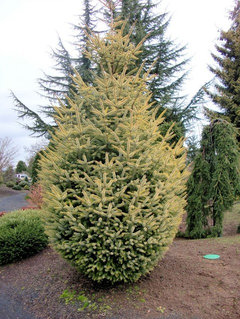
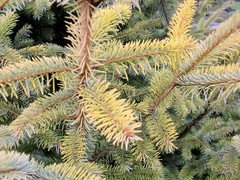
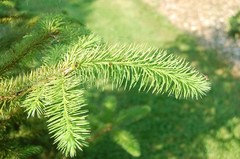
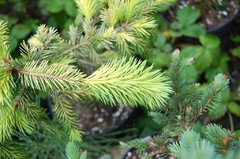



coniferjoy